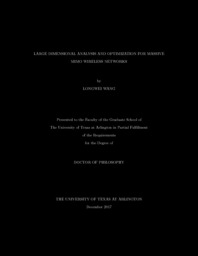
ATTENTION: The works hosted here are being migrated to a new repository that will consolidate resources, improve discoverability, and better show UTA's research impact on the global community. We will update authors as the migration progresses. Please see MavMatrix for more information.
Show simple item record
| dc.contributor.advisor | Liang, Qilian | |
| dc.creator | Wang, Longwei | |
| dc.date.accessioned | 2023-09-11T13:36:16Z | |
| dc.date.available | 2023-09-11T13:36:16Z | |
| dc.date.created | 2017-12 | |
| dc.date.submitted | December 2017 | |
| dc.identifier.uri | http://hdl.handle.net/10106/31642 | |
| dc.description.abstract | The Last decade has seen a massive growth of wireless devices. Demands for high capacity and massive connectivity always increases. To meet the these requirements, massive multiple-input multiple-output (MIMO) technology is proposed for the next generation wireless systems. With massive antenna arrays at the BS, the channel vectors between the users and the BS are asymptotically orthogonal, and the intercell interference can be eliminated with simple linear processing method. The effects of fast fading, and uncorrelated noise tend to disappear as the number of BS station antennas grows large. In this thesis, we mainly focus on the performance analysis and system optimization of massive MIMO cellular networks. We compare two cooperative multicell precoding methods, namely, centralized precoding with global CSI and distributed precoding with local individual CSI in the large dimensional regime. Two different massive MIMO scenarios are considered. When the number of antennas and that of users go large at the same rate, there is a constant gap between the two precoding cases. When the number of antennas goes large, while the number of users is fixed, the performances of both schemes are the same. This means that the impact of local individual CSI vanishes. In the large dimension limit, certain terms such as signal-to-interference-plus-noise ratio (SINR) can be approximated depending only on the statistical CSI. Based on this result, the power optimization problem does not need to adapt as frequently as the instantaneous channel state information. By this means, performance evaluation and optimization is more computationally efficient. Partial interference alignment in finite SNR is proposed, which captures the trade-off between interference avoidance at other users and spatial multiplexing at the intended user. We try to project the interference into partial subspace of the small cell user instead of the full subspace, so that extra improvement on the rate of macro cell can be offered in finite SNR. Large dimensional analysis is provided to obtain the the number of transmit dimensions for small cell in finite SNR. We show that the number of dimensions the small cell can transmit is determined by the singular value distribution of channel matrix and the transmit SNR of the system. In heterogeneous sensor networks, the sensing data may not be compatible with each other due to heterogeneous sensing modalities. We propose a probabilistic inference framework for fusing in formation from heterogeneous sensors. The inherent inter-sensor relationship is exploited to encode the original sensor data in a graph. The iterative belief propagation is used to fuse the local sensing belief. Then we consider the more general correlation case, in which the relation between two sensors is characterized by the correlation factor. The belief propagation provides intuitive insights as to how the local probabilistic update helps to reinforce beliefs when performing information fusion. | |
| dc.format.mimetype | application/pdf | |
| dc.language.iso | en_US | |
| dc.subject | Massive MIMO | |
| dc.subject | large dimension analysis | |
| dc.subject | optimization | |
| dc.title | LARGE DIMENSIONAL ANALYSIS AND OPTIMIZATION FOR MASSIVE MIMO WIRELESS NETWORKS | |
| dc.type | Thesis | |
| dc.date.updated | 2023-09-11T13:36:16Z | |
| thesis.degree.department | Electrical Engineering | |
| thesis.degree.grantor | The University of Texas at Arlington | |
| thesis.degree.level | Doctoral | |
| thesis.degree.name | Doctor of Philosophy in Electrical Engineering | |
| dc.type.material | text | |
Files in this item
- Name:
- WANG-DISSERTATION-2017.pdf
- Size:
- 2.152Mb
- Format:
- PDF
This item appears in the following Collection(s)
Show simple item record


